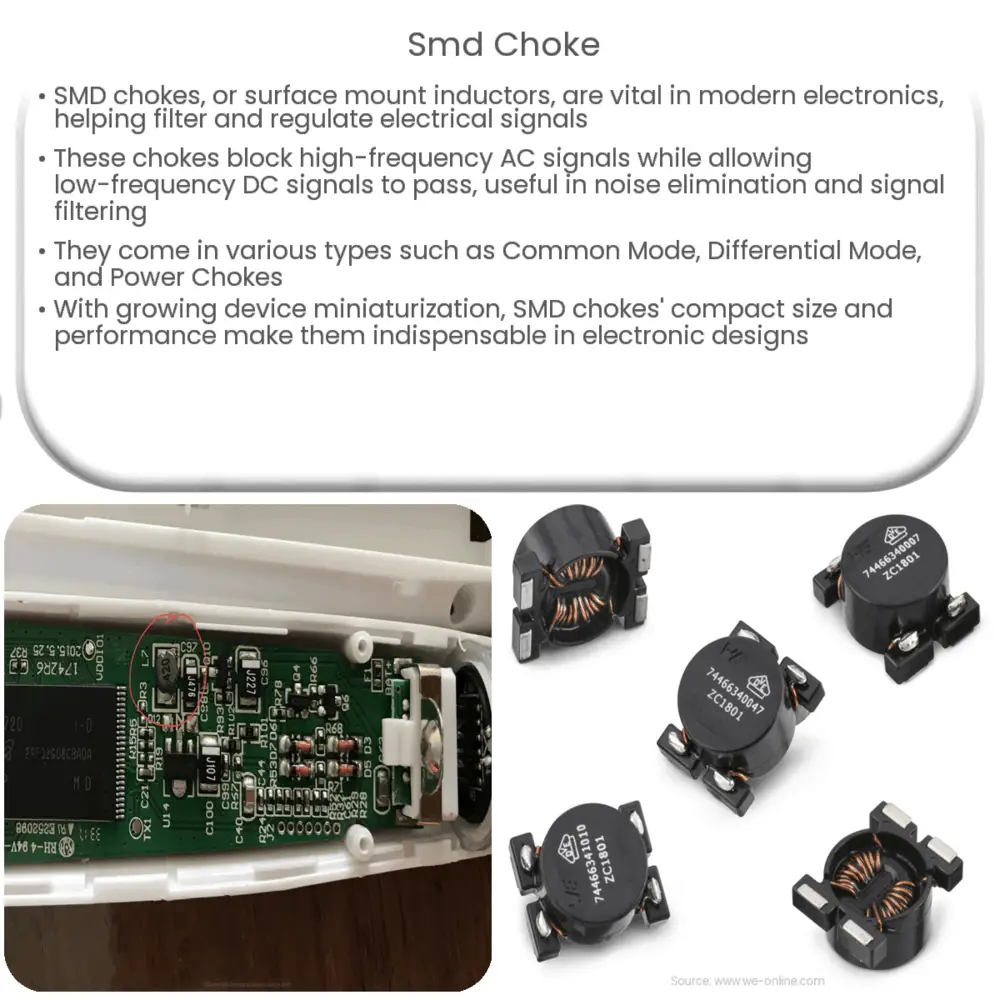An SMD choke is a compact, surface-mount inductor used for filtering high-frequency signals, reducing noise, and regulating electrical signals in modern electronics.

SMD Choke: An Essential Component in Modern Electronics
An SMD (Surface Mount Device) choke, also known as a surface mount inductor, plays a critical role in today’s electronics. Found in various applications, such as power supplies, communication devices, and automotive electronics, SMD chokes are essential for filtering and regulating electrical signals. In this article, we will explore the function, design, and types of SMD chokes, as well as their importance in the realm of modern electronics.
Function of SMD Chokes
At its core, an SMD choke serves as a passive two-terminal electronic component that stores energy in its magnetic field. Chokes are designed to block high-frequency alternating current (AC) signals while allowing low-frequency direct current (DC) signals to pass through. This is particularly useful for eliminating noise, filtering electronic signals, and reducing electromagnetic interference (EMI) in electronic circuits.
Design and Construction
SMD chokes are designed for surface mounting on printed circuit boards (PCBs). Unlike traditional through-hole components, SMD chokes are smaller and lighter, making them suitable for compact and high-density electronic designs. They consist of a coil of wire, usually wound around a magnetic core made of ferrite or iron powder. The core material and number of turns in the coil determine the choke’s inductance value and its ability to filter out high-frequency signals.
Types of SMD Chokes
There are several types of SMD chokes available, each designed for specific applications and requirements. Some of the most common types include:
- Common Mode Chokes: These chokes are designed to filter out common-mode noise present in both the signal and return path. They are commonly used in communication devices, data lines, and power supply filtering.
- Differential Mode Chokes: Differential mode chokes are used to suppress differential mode noise, which occurs between the signal and return path. They are often used in power supplies and DC-DC converters.
- Power Chokes: Power chokes are designed for handling high current applications, such as power supplies and motor drives. They typically have a larger size and a higher inductance value to manage high currents and filter out noise effectively.
- Chip Bead Ferrite Chokes: These are small, bead-shaped chokes that offer excellent high-frequency noise suppression. They are commonly used in signal lines and communication devices.
The Importance of SMD Chokes in Modern Electronics
With the increasing complexity and miniaturization of electronic devices, the demand for high-performance and compact components has grown exponentially. SMD chokes have become a vital part of modern electronic designs due to their ability to effectively filter and regulate electrical signals in a small form factor. Their widespread use in various applications, such as power supplies, communication devices, and automotive electronics, attests to their versatility and importance in ensuring the proper functioning of these devices.
Selection Criteria for SMD Chokes
When selecting an SMD choke for a specific application, several factors need to be considered to ensure optimal performance. Some of these factors include:
- Inductance Value: The inductance value, measured in henries (H), determines the choke’s effectiveness in filtering high-frequency signals. Higher inductance values provide better filtering capabilities, but may also result in increased size and weight.
- Current Rating: The current rating, measured in amperes (A), indicates the maximum current that the choke can handle without overheating or experiencing a significant drop in inductance. Ensure that the selected choke can handle the required current for the specific application.
- DC Resistance: The DC resistance (DCR) of a choke, measured in ohms (Ω), impacts the power loss and efficiency of the circuit. Lower DCR values result in less power loss and higher efficiency.
- Frequency Range: The frequency range of an SMD choke specifies the range of frequencies it can effectively filter. Select a choke with a frequency range that covers the required frequencies for your application.
- Operating Temperature: Ensure that the SMD choke can operate within the temperature range of the intended application, as extreme temperatures can affect the choke’s performance and reliability.
Advantages of SMD Chokes
SMD chokes offer several advantages over their through-hole counterparts, making them the preferred choice for many modern electronic designs. Some of these advantages include:
- Compact Size: SMD chokes are smaller and lighter than through-hole chokes, allowing for more compact and high-density electronic designs.
- Improved Performance: Due to their small size and reduced parasitic effects, SMD chokes generally provide better high-frequency performance and signal integrity than through-hole chokes.
- Easy Assembly: SMD chokes can be easily assembled onto PCBs using automated pick-and-place machines, resulting in faster and more accurate assembly processes.
- Cost-Effectiveness: The use of SMD chokes in automated assembly processes can result in reduced labor costs and increased production efficiency.
Conclusion
SMD chokes have become an integral component in modern electronics due to their compact size, high performance, and versatility across various applications. Understanding the function, design, types, and selection criteria for SMD chokes is essential for engineers and designers to make informed decisions when incorporating these components into their electronic designs. By carefully considering the application requirements and selecting the appropriate SMD choke, designers can ensure the proper functioning and reliability of their electronic devices.

